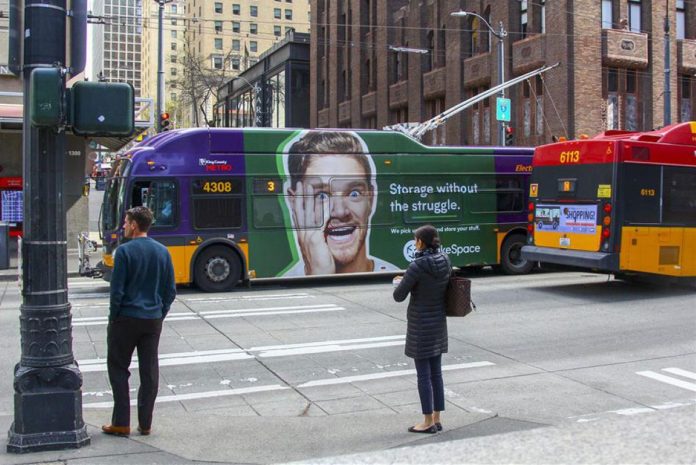
Let’s not do ad kiosks downtown, and while we’re at it, can we please ban those bus wraps that obscure the windows?
When I saw the news about the ad kiosks that may be coming to downtown Seattle, it reminded me of one of my pet peeves: those bus wrap advertisements that cover the windows. I think it’s time King County Metro took those off the menu.
I realize this isn’t the most pressing issue of our day. If you asked a busload of transit riders for their grievances, let alone the population at large, window-obscuring ads would not top the list. But sometimes you gotta sweat the small stuff.
Let’s start with the kiosks, because I don’t love that idea either. As public-private partnerships go, this one doesn’t seem like a spectacular deal. An earlier, more extensive plan was shelved by then-mayor Jenny Durkan in 2018. The bid-winning company planned to build and maintain transit shelters as well as kiosks, and the city was to receive a cut of the ad revenue projected at $100 million-plus over a 20-year period. Now it’s just kiosks and a much smaller amount of revenue, mostly flowing to the Downtown Seattle Association. The kiosks of the earlier proposal included useful amenities like charging stations and free phone calls, which seem to have been excluded by design this time to discourage “loitering,” a.k.a. use by homeless people.
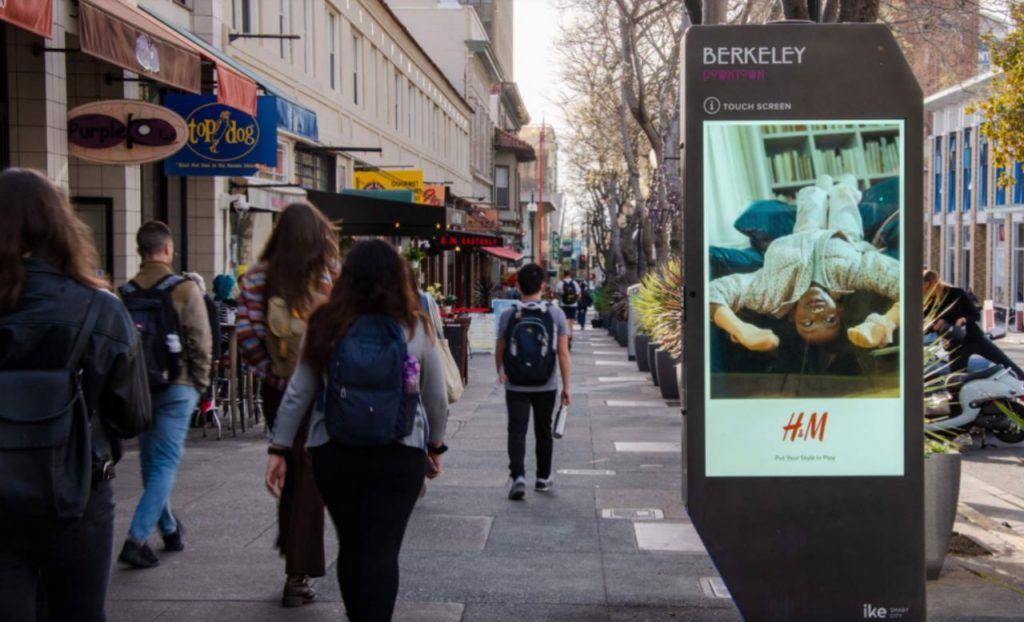
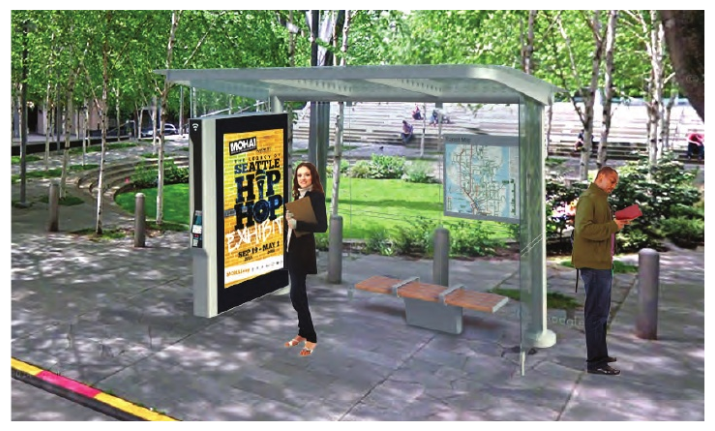
But here’s another idea: Maybe we could stop trying to sell transit riders’ eyeballs altogether. Maybe I marinated in too much culture-jamming anti-consumerism as a teenager, but I’ll take my public space beautiful and ad-free.
I admit to being prejudiced against advertising generally. Mainstream economic theory holds that advertising performs a useful function, reducing market friction, pairing consumers with the products they will most enjoy, helping to maximize total utility. That, the story goes, justifies the now-vast social and material resources that go into the creation and proliferation of advertisements. I think that’s a load of hooey.
I’ve also heard it argued that ads can have artistic merit. Okay, sure. But if artistry occasionally elevates an advertisement, advertising limits and debases art. What if David Lynch only made commercials? Other people can have their nuanced opinions. In my book, the advertising industry represents a spectacular waste of human labor and creativity, and constant exposure to ads pollutes our minds and our souls.
It’s unfortunate, therefore, that ad revenue powers so much that’s good and necessary in our lives, from news journalism to the whole internet. This seems to me one of the surest signs of 21st century capitalism’s moral senescence. What should be public goods, freely available to all, can’t exist without hyperconsumerism and the commodification of our attention down to the fleeting glance. If that’s not crazy, what is?
One of the things I’m most looking forward to about the future socialist utopia is that human beings will find less degrading and manipulative ways to inform each other about the vast range of goods that are available to us.
But I digress. Let’s get back to those window-obscuring bus wraps. You don’t have to detest all advertising or be a wild-eyed radical to agree that windows are for seeing through.
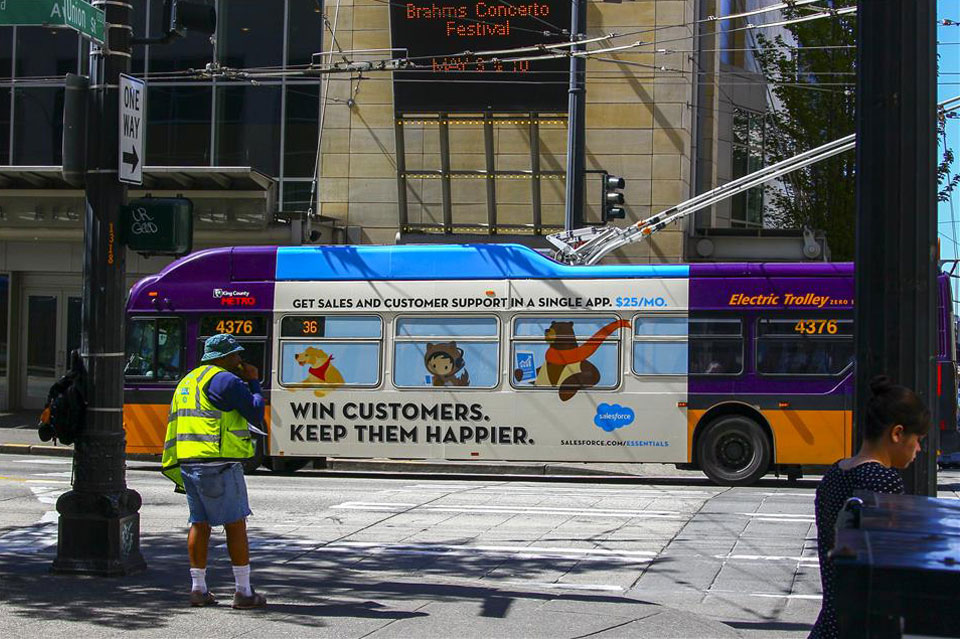
I ride Metro buses almost every day, usually with my baby daughter. Part of the joy of riding public transit is the big windows, catching a glimpse of the mountains or the water, looking down at people in their cars, watching the world go by. The baby loves it. Getting on board and realizing we can barely see outside is a bummer, for me and for her. Think of the children!
This isn’t only about aesthetics or entertainment. Sometimes you actually need to look out the window to know when to get off the bus. It helps to be able to see street signs and landmarks instead of relying on the stop announcements, which are sometimes ill-timed, hard to hear, or not working.
Is there any precedent for banning bus wraps? A quick Google search (powered by ads!) reveals that Albuquerque’s city council did so last year. The councilor who proposed it thought that the buses should look clean, professional, and recognizable as public transit. And he felt it was a safety problem to be unable to see into the bus from the outside.
It’s never occurred to me that I might board a bus and find myself in the middle of a knife fight because I couldn’t see in. But politics makes strange bedfellows. Seattle City Council, I’m looking at you. How about spending the next few months fine-tuning legislation to ban window-obscuring bus ads from Seattle’s streets? This is an urgent public safety issue! All that mess about gig workers and the minimum wage will have to wait.
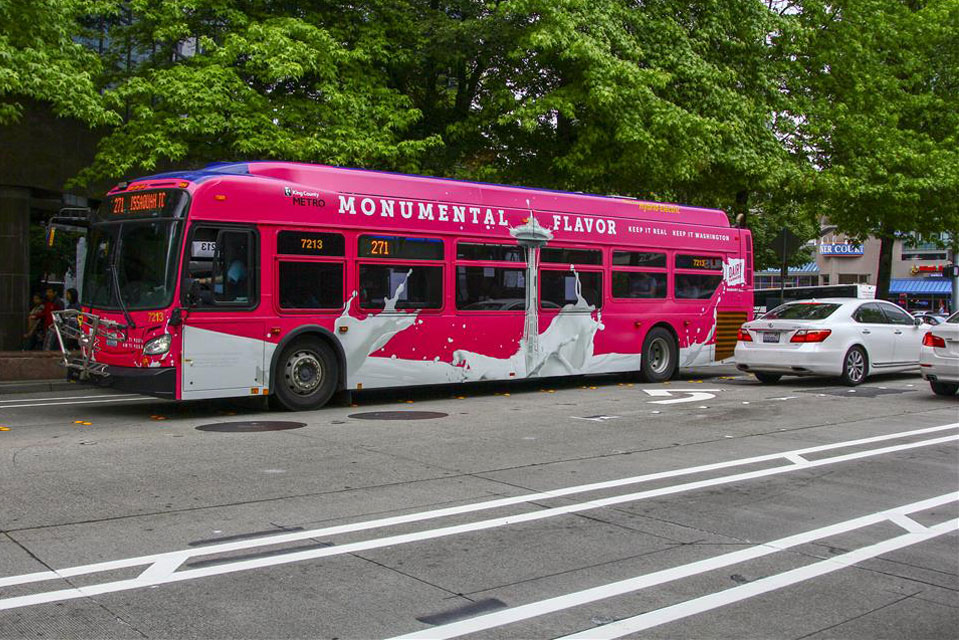
What would this mean for King County Metro? The agency does, after all, derive some revenue from bus wraps. But, looking at the examples on the agency’s bus advertising webpage, not all wraps obscure the windows. Much as I prefer Metro livery over gaudy displays promoting yogurt or car insurance, I’m no extremist. Metro can continue touting Seattle’s “well-known slow moving traffic” as a boon to advertisers.
It’s true that Metro is in need of money. But it needs a lot more money. To achieve the Metro Connects goal of “bringing frequent service to within a half mile of 80% of the county’s population and expanding flexible transit options” would require “approximately twice Metro’s current funding capacity.” We’re talking many hundreds of millions of dollars a year in operating costs, to say nothing of the billions in capital costs.
I hope that King County will soon figure out a plan to fully fund Metro’s long-term expansion. In comparison, revenue derived from advertising is truly a drop in the bucket. In 2023, King County Metro’s total net revenue from advertising was $3.1 million, which is less than 0.5% of Metro’s operating budget. A Metro spokesperson said that less than half of ad revenue (about $1.4 million in 2023) is generated by bus wraps; the rest is from other advertising formats, such as framed ads, interior cards, and bulkheads.
Whatever money is foregone by insisting on designs that leave the windows clear, it’s a small price to pay for the view from the bus.
Update: This article was updated at 8pm Monday with the ad revenue figures that Metro provided.
Katie Wilson is General Secretary of the Transit Riders Union, a Seattle-based organization advocating for improving transit quality and making access more equitable. In 2025, she launched a run for Seattle Mayor.

